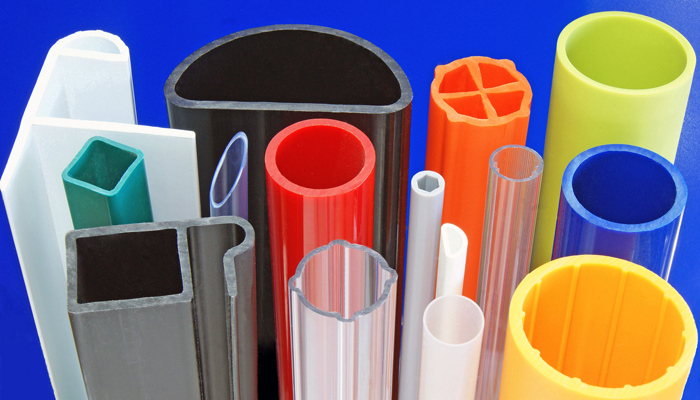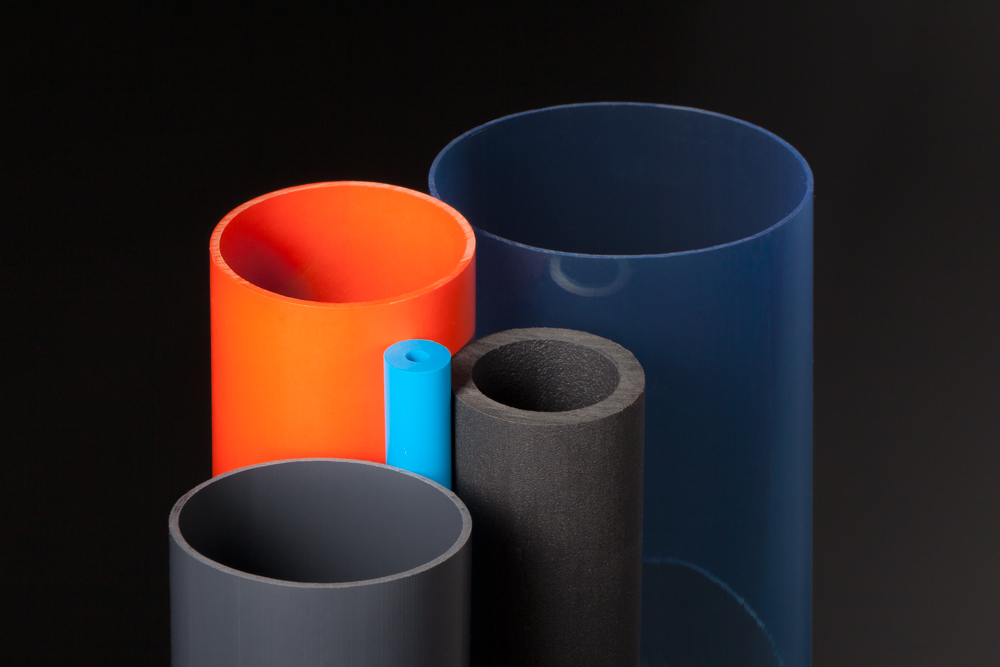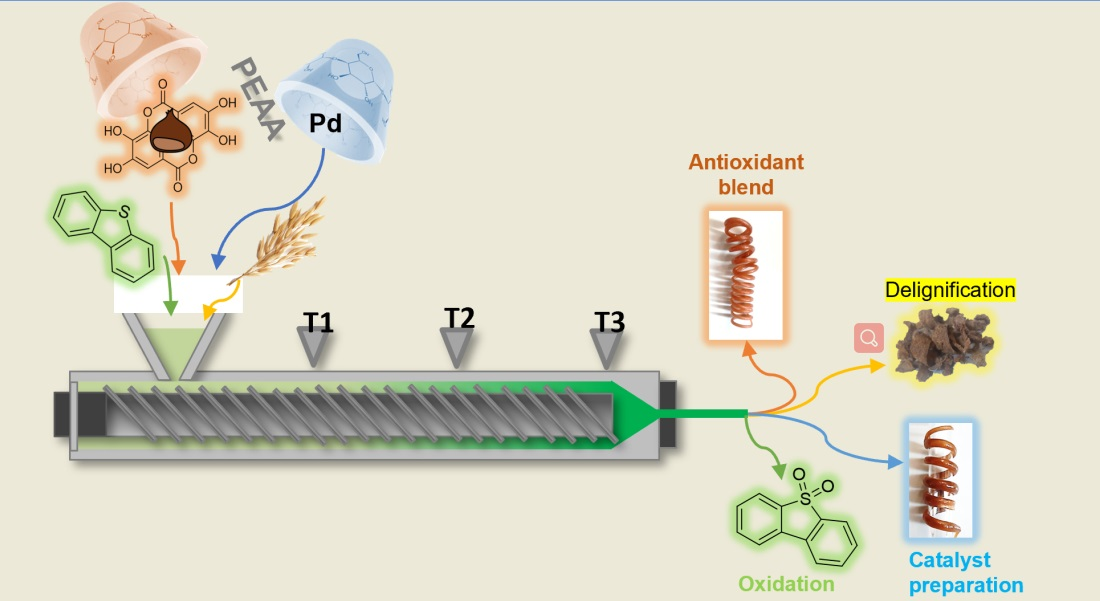Plastic tubes are extruded by melting resin pellets in a heated barrel, pushing it through a die with a screw, and cooling the shaped output.

Materials and Pre-processing
Types of Plastics Used for Extrusion
Plastics have become an essential material in various industries due to their versatility, durability, and cost-effectiveness. Some of the commonly used plastics for extrusion include:
- Polyethylene (PE): Polyethylene is one of the most popular plastics for extrusion due to its flexibility and affordability. It comes in various densities like High-Density Polyethylene (HDPE) and Low-Density Polyethylene (LDPE). Typical applications include water pipes and packaging films. The average cost for PE is around $1.20 per kilogram.
- Polypropylene (PP): Polypropylene is known for its excellent chemical resistance and high-temperature stability. Common applications include automotive parts and food containers. It typically costs about $1.50 per kilogram.
- Polyvinyl Chloride (PVC): PVC is favored for its durability and rigidity. It’s commonly used in window profiles, pipes, and cable insulation. The average price of PVC is around $1.10 per kilogram.
- Polystyrene (PS): Used in applications requiring clarity and stiffness, like food packaging and disposable cutlery. It has an average cost of $1.40 per kilogram.
Knowing the type of plastic and its specific properties helps in determining the optimal extrusion parameters, ensuring both quality and efficiency.
Preparing Plastic Resins: Drying and Mixing
Before the extrusion process, plastic resins must undergo specific pre-processing steps:
- Drying: Most plastics absorb moisture from the atmosphere, which can degrade the quality of the final product. A typical drying process involves circulating hot air at about 80°C through the resin pellets for approximately 4 hours. The aim is to bring down the moisture content to below 0.02%.
- Mixing: To achieve desired product characteristics, different additives and colorants might be added to the base resin. A mixer or blender is used to ensure uniform distribution of these additives. The mixing process usually takes around 20 minutes, and precise control over speed (about 60 RPM) and temperature (around 25°C) ensures optimal mixing efficiency.
The Extrusion Machine
Parts of an Extrusion Machine
The Hopper
The hopper is the starting point of the extrusion process, serving as the container where plastic resins are loaded. Made of stainless steel to avoid contamination, a typical hopper can hold around 50 kilograms of resin pellets. The design ensures a consistent and uninterrupted flow of resins into the barrel. Some advanced hoppers come with features like moisture sensors, ensuring that the resins are dry and ready for extrusion.
The Barrel
The barrel of the extrusion machine is where the actual melting of the plastic occurs. Typically made of alloy steel, it is lined with a wear-resistant material due to the constant friction from the rotating screw. The barrel’s length is about 20 times its diameter, ensuring sufficient time and space for the plastic to melt uniformly. Depending on the machine’s size, the diameter can range from 25mm to 250mm.
The Screw
The screw plays a crucial role in pushing, melting, and mixing the plastic. With an average rotational speed of 60 RPM, it’s designed with varying depths to control the melting process. Made of hardened steel, the screw has a lifespan of around 10,000 operational hours before wear and tear demand a replacement.
The Die
The die is the final part of the extrusion machine, giving the molten plastic its shape. It’s crucial to have precision-cut dies to ensure the final product meets the desired specifications. Depending on the complexity of the design, a die can cost between $1,000 to $10,000.
Temperature Control during Extrusion
Maintaining the right temperature is crucial for quality extrusion. The barrel usually has several heating zones, each with its individual heater and thermostat. Typically, these heaters operate at a power range of 15 to 25 kW, ensuring that the plastic melts uniformly without degradation.
Cooling systems, often water-cooled, ensure that the machinery remains at optimal temperatures, preventing overheating. The efficiency of these systems is vital as any temperature fluctuations can lead to inconsistencies in the product’s quality.
Tube Extrusion Process
Setting up the Extrusion Machine for Tubing
When gearing up for tube extrusion, it’s crucial to calibrate the machine for specific requirements. Firstly, one must choose the right type of plastic material. Each material requires a distinct temperature range for optimal melting, often between 150°C to 250°C.
The size of the die opening corresponds to the desired outer diameter of the tube, which can vary from as small as 1mm for medical tubes to over 150mm for industrial applications.
For tubing, the average speed ranges from 5 meters/minute for thicker tubes to 50 meters/minute for thinner ones. Proper synchronization of the screw speed, which typically lies between 40 to 80 RPM, with the puller speed ensures consistent wall thickness.
The Role of the Mandrel in Tube Extrusion
A critical component in tube extrusion is the mandrel, sometimes referred to as a “pin” or “core.” It determines the inner diameter of the tube. Positioned within the die, the mandrel ensures that the extruded material flows around it, creating a hollow center.
The gap between the mandrel and the die defines the tube’s wall thickness. For example, for a water supply tube with a 25mm outer diameter and a 20mm inner diameter, the gap would be 2.5mm on all sides. Precision in positioning the mandrel is essential, as even minor misalignments can result in uneven wall thickness, compromising the tube’s quality and functionality.
Cooling and Sizing the Extruded Tube
Once the molten plastic exits the die, it’s essential to cool and solidify it promptly to retain its shape. Water is the most common cooling medium, and cooling tanks, typically 3 to 6 meters long, are used for this purpose. The water temperature in these tanks is maintained at about 15°C to 20°C.
Immediately after cooling, the tube enters the sizing phase. Sizing sleeves or vacuum sizers ensure the tube’s dimensions are accurate. For a tube meant to fit into standard connectors, even a 0.5mm deviation in diameter can render it unusable.
The pulling speed, which might range from 5 to 50 meters/minute depending on the tube’s thickness and material, is crucial to maintain the tube’s consistency.
Post-extrusion Processes
Cutting and Coiling
Once the tube exits the extrusion line, it’s directed towards the cutting unit. Depending on the intended use, tubes can be cut into specific lengths. For instance, medical tubes might be cut into 2-meter lengths, while industrial hoses might be segmented into 10-meter lengths. Automated cutting machines achieve these precise lengths with an accuracy of ±0.5mm.
For applications that require longer, continuous lengths, the tubes are coiled. Coiling machines wrap the tubes onto spools, with some spools accommodating up to 500 meters of tubing. The cost of a standard coiling machine can range from $10,000 to $50,000, depending on its capacity and automation level.
Surface Treatments and Printing
Post-extrusion, some tubes undergo surface treatments to enhance their properties or aesthetics. Treatments like corona treatment improve the tube’s adhesion properties, crucial when the tube needs labeling or further processing. The treatment involves exposing the tube’s surface to a high-voltage electrical discharge, enhancing its molecular structure for better adhesive qualities.
Printing on tubes, especially for branding or conveying critical information, employs inkjet or flexographic printing methods. Printing costs can vary, with high-resolution prints costing up to $0.05 per print, depending on the design’s complexity and the ink type.
Quality Control and Testing
Ensuring the extruded tubes meet the required specifications and are free from defects is paramount. Quality control involves multiple tests:
- Dimensional Tests: Measures the tube’s outer and inner diameters, ensuring they match the desired specifications. A deviation of more than 1% from the intended dimensions can lead to rejection.
- Tensile Tests: Checks the tube’s strength. A typical PVC tube should have a tensile strength of about 50 MPa.
- Burst Tests: Assesses the maximum pressure a tube can withstand before bursting. For instance, a standard water supply tube should handle pressures up to 10 bars.
- Visual Inspection: Trained personnel or automated cameras scrutinize the tube’s surface for imperfections like bubbles, discolorations, or unevenness.

Advancements in Tube Extrusion Technology
Computer-aided Design (CAD) in Extrusion
With the integration of Computer-aided Design (CAD) into the extrusion process, designing and testing tube prototypes have become more precise and time-efficient. CAD software, such as SolidWorks or AutoCAD, allows engineers to draft detailed tube designs with exact measurements, down to tolerances of 0.01mm.
Using CAD, manufacturers can simulate the extrusion process, evaluating how different materials and settings will affect the final product. This virtual testing reduces the need for physical prototypes, cutting down material costs by up to 20% and saving weeks in the development cycle.
Automation and Robotics in Extrusion
Automation has ushered in a new era of efficiency and precision in tube extrusion. Automated extrusion lines, equipped with sensors and feedback loops, can adjust parameters such as temperature, speed, and pressure in real-time, ensuring consistent quality. These adjustments, which can be made every few milliseconds, have improved production efficiency by up to 30%.
Robotics also plays a pivotal role, especially in post-extrusion processes like cutting, coiling, and packaging. Robotic arms with precision levels of ±0.5mm handle tasks with speed and accuracy, reducing manual labor and associated errors. An average robotic arm used in extrusion lines can cost between $20,000 to $50,000, but the return on investment is quick due to increased throughput and reduced wastage.
Innovations in Material Science and Blends
The extrusion industry has benefited immensely from innovations in material science. New polymer blends, which combine the best properties of different plastics, are constantly being developed. For instance, a blend of Polyethylene (PE) and Polypropylene (PP) can offer flexibility and chemical resistance, making it perfect for specific applications like chemical delivery tubes.
Biodegradable and recycled plastics are also gaining traction. New formulations of Polylactic Acid (PLA) tubes, which decompose in a few years, are being adopted, especially in environmentally-conscious markets. These sustainable materials, though 10-15% more expensive than traditional plastics, offer long-term benefits in reducing environmental impact.

Environmental Impacts and Sustainability
The Issue of Plastic Waste
The environmental impact of plastics, especially in terms of waste, has become a topic of global concern. The rest ends up in landfills, oceans, and other ecosystems, posing threats to wildlife and the environment.
Tubes, being a segment of plastic products, contribute to this problem. For instance, a single industry, like healthcare, might use up to 10 million kilometers of medical tubing annually. If not managed properly, these tubes can end up as waste, taking hundreds of years to degrade.
However, the alarming numbers have led to increased awareness and urgency to address the plastic waste crisis. As a result, the extrusion industry is taking strides to mitigate its impact and contribute to sustainable solutions.
Recycling and Biodegradable Plastics in Extrusion
Recycling has become an integral part of the extrusion industry’s sustainability approach.
Moreover, the industry is leaning into biodegradable plastics. Materials like Polylactic Acid (PLA) or Polyhydroxyalkanoates (PHA) are now being used to produce tubes that decompose within years rather than centuries. Though these materials can cost up to 20% more than traditional plastics, their environmental advantages make them an appealing choice for industries and consumers alike.
Sustainable Practices in the Industry
Beyond material choices, the extrusion industry is integrating sustainable practices throughout its operations. Energy-efficient machines, some reducing energy consumption by up to 40%, are becoming the industry standard.
Water recycling systems in extrusion factories ensure that the vast amounts of water used in cooling processes are reused, leading to reductions in water consumption by up to 50%.
Additionally, industry partnerships with environmental organizations are on the rise. These collaborations focus on research, community outreach, and initiatives aimed at reducing the plastic footprint. Manufacturers are also investing in educating consumers about proper disposal and recycling of tube products to ensure they don’t end up polluting the environment.




